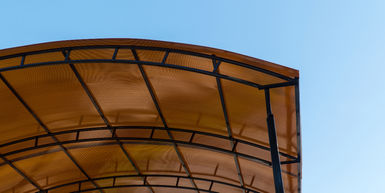Posted by Farco Plastics on 13th Oct 2023
Multiwall Plastic Materials

With the advent of advanced building materials, multiwall plastics have emerged as a crucial element in modern construction and design. This guide offers a detailed look into multiwall plastics and how they're transforming the industry.
What are Multiwall Plastic Materials?
At its core, multiwall plastics refer to a type of sheeting characterized by multiple layers. Regular plastic sheets have one layer, but multiwall plastics have many layers with little pockets or chambers between them. These structures, often described in terms like "twin-wall" or "triple-wall", play a pivotal role in the plastic's functionality.
Multiwall plastics primarily emerge from two dominant base materials:
Polycarbonate (PC):
Description: Polycarbonate is a thermoplastic polymer known for its strength and clarity. Unlike many other plastics, it's exceptionally transparent, allowing for the transmission of light almost as efficiently as glass.
Advantages:
- Strength:
- Polycarbonate multiwall sheets are virtually unbreakable, offering impact resistance up to 200 times greater than glass.
- Light Transmission:
- Even though these sheets are strong, they let a lot of light in, which makes them great for things like greenhouses or skylights.
- UV Resistance:
- Many multiwall polycarbonate plastics have UV protection to stop them from turning yellow and protect the inside from harmful UV rays.
- Temperature Tolerance:
- Polycarbonate can endure extreme temperatures without losing its structural integrity.
Applications:
People commonly use multiwall polycarbonate sheets in greenhouses, roofing, glazing, safety glasses, and bulletproof windows.
Polypropylene (PP):
Description: Polypropylene is another thermoplastic polymer, but unlike polycarbonate, it's more flexible and has a different set of attributes.
Advantages:
- Flexibility:
- Polypropylene sheets are more flexible than polycarbonate, making them ideal for applications that require bending or shaping.
- Chemical Resistance:
- PP is resistant to most chemicals, making it suitable for environments where chemical exposure might be a concern.
- Moisture Resistance:
- Polypropylene does not absorb water, ensuring longevity in moist environments.
- Eco-friendliness:
- PP is 100% recyclable, aligning with the push for greener building materials.
Applications:
Because of its properties, manufacturers often use multiwall polypropylene in signage, packaging, automotive parts, and some household goods.
Tracing back to its origins, multiwall plastics began as an alternative to traditional building materials. With the push for materials that were durable yet lightweight, and cost-effective but versatile, polycarbonate and polypropylene emerged as frontrunners. When we structure these base materials into multiwall designs, they open up many opportunities. As a result, various industries have widely adopted multiwall plastics.
Benefits of Multiwall Plastics in Construction
Multiwall plastics are not just another material in the builder's arsenal; they're transforming construction paradigms. Let’s explore why:
- Durability and Resilience:
- Multiwall plastics stand the test of time. Resistant to impacts, they can endure environmental stressors like wind, rain, and UV rays without significant wear and tear.
- Cost-Effectiveness:
- Multiwall plastics are more expensive initially. However, they prove to be cost-effective in the long term. This is because they are highly durable and require less maintenance. In comparison to traditional materials, multiwall plastics offer significant savings.
- Insulation:
- These plastics excel in thermal insulation. Their multi-layered design helps keep interiors cool in the summer and warm in the winter, saving energy.
Multiwall Plastics for Green Building Solutions
Beyond their functional benefits, multiwall plastics play a pivotal role in the sustainable building movement. These plastics are made from recyclable materials and can be repurposed at the end of their life cycle, reducing environmental waste. Moreover, their energy-saving insulation properties contribute to green building certifications, making them a favored choice for eco-conscious projects.
Comparing Multiwall Plastics to Other Materials
Traditional building materials have their place, but when stacked against multiwall plastics, the latter often comes out on top. For instance, while single-wall plastics might offer transparency, they lack the insulation and durability of multiwall alternatives. Glass, though a good insulator, doesn't resist impact as well and is much heavier, which limits its use.
The Future of Multiwall Plastics in Industry
The trajectory for multiwall plastics looks promising. Industries are leaning towards sustainable, cost-effective, and versatile materials, and these plastics are set to dominate. However, like any material, they're not without challenges. Research continues to enhance their UV resistance, improve their recyclability, and expand their application spectrum.
Conclusion
Multiwall plastics, with their myriad advantages, have firmly established themselves as a cornerstone in modern material science. From construction to design, their impact is undeniable. As we move towards a future where efficiency, sustainability, and versatility intertwine, multiwall plastics will undoubtedly play a pivotal role. For professionals and enthusiasts alike, understanding and harnessing the potential of these materials will be key.

